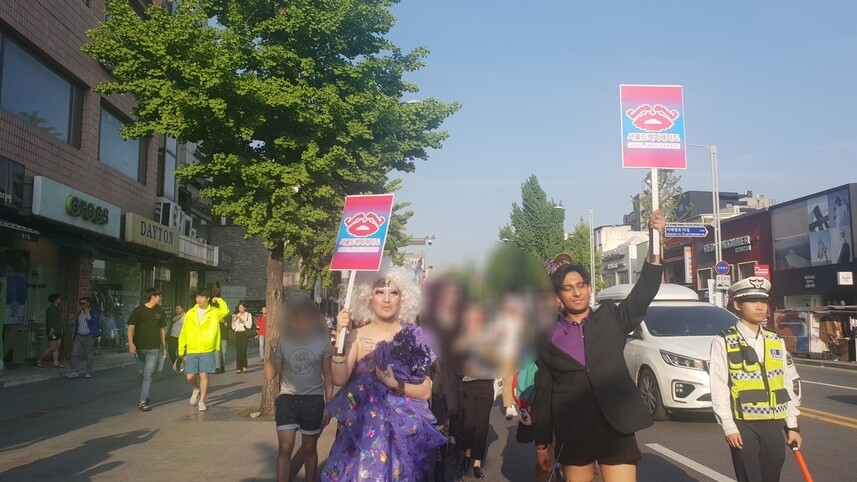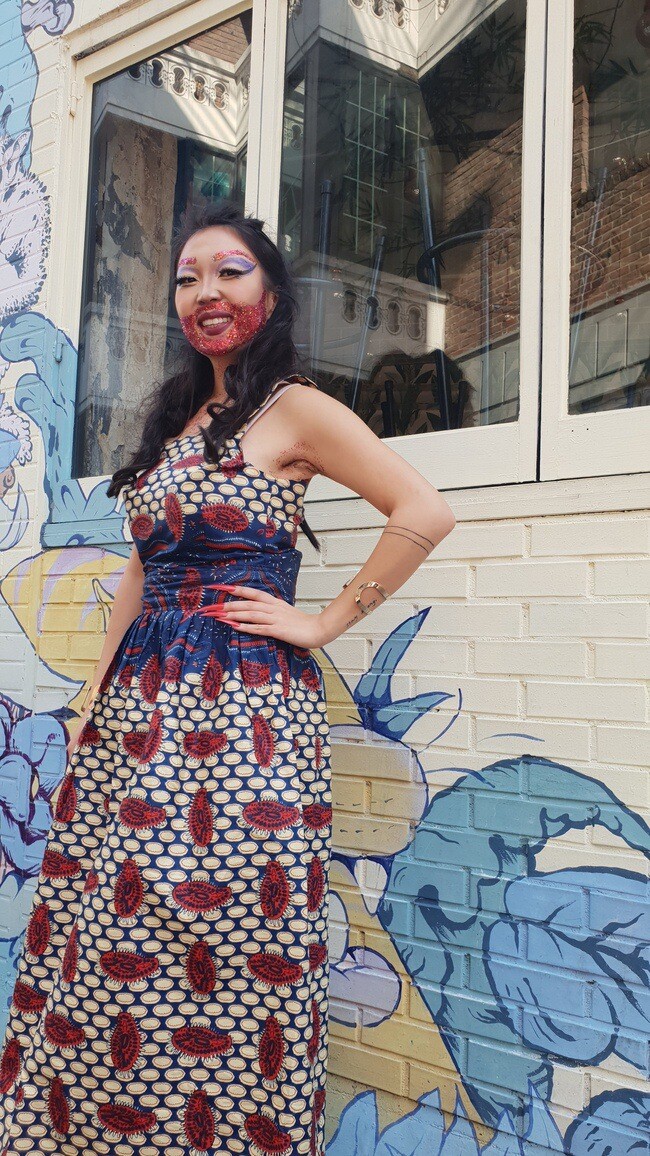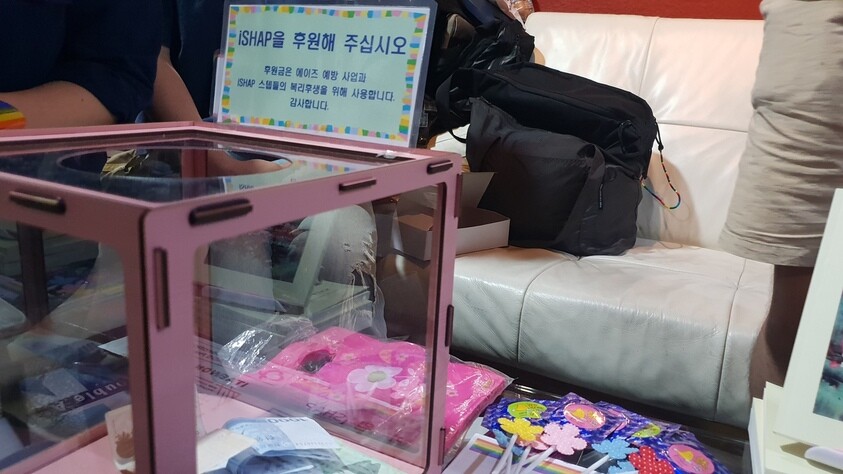hankyoreh
Links to other country sites 다른 나라 사이트 링크
2nd Seoul Drag Parade kicks off in Haebangchon

At 5 pm on May 5, around 300 people paraded through Seoul’s Haebangchon neighborhood wearing colorful wigs and thick makeup reminiscent of musical theater performers.
“Is this a queer parade?” whispered onlookers as the paraders strode along the street. Meanwhile, the participants waved and smiled broadly at the watching citizens. It was a setting where terms like “masculine” and “feminine” held no meaning. Gender-based distinctions held no place – the skirts and high heels typically seen as reserved for women, the black suits and neckties seen as exclusive to men. The people were taking part in the second Seoul Drag Parade, held this year in the Haebangchon area of Seoul’s Yongsan district, near Itaewon. Participants walked for just over a half hour that day from Haebangchon to the neighboring Itaewon area. It was the final day of an event that started on May 3.
The outfits were part of an area of LGBT culture exemplified by “drag” and “drag queens.” It refers to a culture of expressing one’s identity through clothing and makeup without regard for gender distinctions of sexual identity. Drag culture first gained attention in South Korea thanks to the drag queens appearing in popular musicals such as “Kinky Boots” and “Hedwig and the Angry Inch.”

At the very front of the parade, the chairperson of the Seoul Drag Parade organizing committee, a 29-year-old identified by the working name Heezy Yang, carried a sign bearing the name of the event. Heezy Yang, who first got into drag culture in 2014, was holding the Drag Parade event for a second straight year.
“Drag is a means for anyone, LGBT or not, to leave behind societal oppression and the gender roles demanded by society and freely engage in self-expression,” he said.
“The Drag Parade is a human rights movement that is about discovering yourself and fighting against preconceptions by using costumes and makeup for expression without concern for gender differences or preconceived notions about how men and women ‘should be,’” he added.

Drag culture is not the same as LGBT culture
According to Heezy Yang, a big difference between the Drag Parade and the Queer Culture Festival event is that the former focuses on drag culture, while the latter is concerned with LGBT culture as a whole.
At the same time, he said the event was “similar” to the Queer Parade – scheduled for June 1 – in sharing the “goal of getting LGBT people to come out in public to advance their human rights.” Indeed, the organizers stirred up greater interest in LGBT issues by increasing the event’s duration from just one day last year to three days this year. It began with a drag culture photo exhibition on May 3, followed by the screening of queer-themed films such as “Itaewon Urban Legend” and “Ultra Blue” and a conversation with the directors on May 4.

“We did a three-day event this time in order to convey not just drag’s aspects as a form of entertainment culture you might find in clubs, but also its artistry through exhibitions and screenings,” Heezy Yang explained.
“I didn’t see going to demonstrations and waving signs as the only way of campaign for human rights. I think it’s a form of human rights campaigning when we express ourselves and give courage and inspiration to others,” he added.
“Drag shows are things you usually only see at night in clubs. The significance of the Drag Parade lies in showing LGBT culture openly and awakening interest by having people walking the streets proudly in broad daylight.”
Some of the booths set up before the parade including one promoting the LGBT AIDS prevention center ISHAP and a space for writing letters of encouragement to LGBT people.

With the festival designed as an event for everyone, the organizers also created opportunities for young people to participate. With drag shows and other performances by drag queens held mainly at night in clubs, young people who do not have access to the clubs have few opportunities to encounter drag culture. Coming on the heels of last year’s “alcohol-free drag show,” this year’s Seoul Drag Parade allowed younger people access to events for all three days (apart from the after-party on the last night).
Also notable in the parade were the participants who were not dressed in drag. Park Hyeon-seo, a 27-year-old who works with a theater company, explained, “I first encountered drag culture at a club in 2016, and I just thought at the time that it was a culture of gay men dressing in women’s clothing.”
“I developed an interest as I learned about what an appealing culture it is, without concern for preconceptions about things like gender roles,” Park said.
Skim, who gave a drag performance before the parade that day, explained, “What I find appealing about drag culture is how I can break down gender distinctions and express myself freely.”

Drag is not about men imitating women
Commenting on the controversy over the perceived mockery of women and transgender persons, Heezy Yang said, “My understanding is that those charges were made about certain people who enjoy drag culture, with things like men excessively emphasizing women’s bodies.”
“But the essence of drag is not about gay men imitating women,” he added.
“I don’t do drag because I want to imitate women. I do drag because I want to express myself freely and shed entrenched gender roles about ‘masculinity’ and ‘femininity,’ without negating the fact that I’m a man. I also think that’s a message that we need to make sure is clearly communicated to the public going forward.”
The Seoul Drag Parade organizing committee said it plans to hold events annually in the future.
“We also aim to broaden the setting beyond Itaewon so that more people can take an interest not only in terms of the entertainment aspect of drag culture, but also its human rights-related and artistic aspects,” the committee said.
By Oh Yeon-seo, staff reporter
Please direct comments or questions to [english@hani.co.kr]

Editorial・opinion
![[Column] Has Korea, too, crossed the Rubicon on China? [Column] Has Korea, too, crossed the Rubicon on China?](https://flexible.img.hani.co.kr/flexible/normal/500/300/imgdb/original/2024/0419/9317135153409185.jpg) [Column] Has Korea, too, crossed the Rubicon on China?
[Column] Has Korea, too, crossed the Rubicon on China?![[Correspondent’s column] In Japan’s alliance with US, echoes of its past alliances with UK [Correspondent’s column] In Japan’s alliance with US, echoes of its past alliances with UK](https://flexible.img.hani.co.kr/flexible/normal/500/300/imgdb/original/2024/0419/2317135166563519.jpg) [Correspondent’s column] In Japan’s alliance with US, echoes of its past alliances with UK
[Correspondent’s column] In Japan’s alliance with US, echoes of its past alliances with UK- [Editorial] Does Yoon think the Korean public is wrong?
- [Editorial] As it bolsters its alliance with US, Japan must be accountable for past
- [Guest essay] Amending the Constitution is Yoon’s key to leaving office in public’s good graces
- [Editorial] 10 years on, lessons of Sewol tragedy must never be forgotten
- [Column] A death blow to Korea’s prosecutor politics
- [Correspondent’s column] The US and the end of Japanese pacifism
- [Guest essay] How Korea turned its trainee doctors into monsters
- [Guest essay] As someone who helped forge Seoul-Moscow ties, their status today troubles me
Most viewed articles
- 1[Column] The clock is ticking for Korea’s first lady
- 2Hong Se-hwa, voice for tolerance whose memoir of exile touched a chord, dies at 76
- 3[Column] Has Korea, too, crossed the Rubicon on China?
- 4After 2 months of delayed, denied medical care, Koreans worry worst may be yet to come
- 5[Correspondent’s column] In Japan’s alliance with US, echoes of its past alliances with UK
- 6All eyes on Xiaomi after it pulls off EV that Apple couldn’t
- 7[Photo] Smile ambassador, you’re on camera
- 8US overtakes China as Korea’s top export market, prompting trade sanction jitters
- 9S. Korea “monitoring developments” after report of secret Chinese police station in Seoul
- 1075% of younger S. Koreans want to leave country